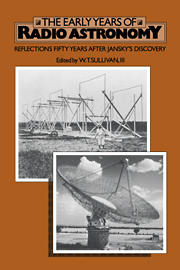Book contents
- Frontmatter
- Contents
- Preface
- THE EARLIEST YEARS
- AUSTRALIA
- The origins of radio astronomy in Australia
- The first decade of solar radio astronomy in Australia
- Early days in radio and radar astronomy in Australia
- Radio sources and the log N–log S controversy
- Early work on imaging theory in radio astronomy
- ENGLAND
- THE REST OF THE WORLD
- BROADER REFLECTIONS
- Biographical notes on contributors
- Name index
- Subject index
Early days in radio and radar astronomy in Australia
Published online by Cambridge University Press: 05 March 2010
- Frontmatter
- Contents
- Preface
- THE EARLIEST YEARS
- AUSTRALIA
- The origins of radio astronomy in Australia
- The first decade of solar radio astronomy in Australia
- Early days in radio and radar astronomy in Australia
- Radio sources and the log N–log S controversy
- Early work on imaging theory in radio astronomy
- ENGLAND
- THE REST OF THE WORLD
- BROADER REFLECTIONS
- Biographical notes on contributors
- Name index
- Subject index
Summary
As in other countries, the first discoveries of Jansky and Reber in radio astronomy made little impression in Australia. Rather, interest in the subject was first aroused by news of the wartime discoveries of radio emission from the Sun by J. S. Hey in England and G. C. Southworth in the United States. As World War II wound down in 1945, the CSIR (later CSIRO) Radiophysics Laboratory in Sydney was ending its work on the development of radar equipment for the South West Pacific theatre of war. A wise decision was made to keep this highly experienced and imaginative group of people together and to look for new scientific and technical challenges. With the strong administrative encouragement of E, G. (Taffy) Bowen and the scientific foresight of J. L. Pawsey, the group turned its curiosity to radio astronomy, and in this way Australia got an early start in the opening up of this new branch of science (see the contribution by Bowen elsewhere in this volume). Those were exciting days and new discoveries came rapidly as existing equipment could be turned over to the exploration of the almost unknown radio sky.
“COSMIC NOISE”
Some experiments had been made in 1944 by Pawsey and Ruby Payne-Scott from the roof of the Radiophysics Laboratory building in the grounds of Sydney University, but the first significant observations were made by pointing antennas of Air Force and Army radar stations near Sydney at the Sun. The first years of solar work in Australia are described by W. N. Christiansen elsewhere in this volume.
- Type
- Chapter
- Information
- The Early Years of Radio AstronomyReflections Fifty Years after Jansky's Discovery, pp. 133 - 146Publisher: Cambridge University PressPrint publication year: 1984
- 9
- Cited by

